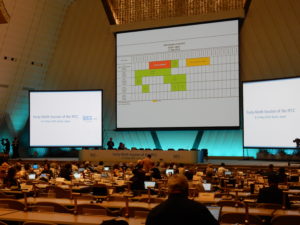
Tracking molecules of greenhouse gases: Dr. Stephen Ogle contributes to latest methodologies adopted by the Intergovernmental Panel on Climate Change
As the summer comes to an end and you reflect upon sitting in traffic as you traveled home from your summer vacation, the contribution of fossil fuel combustion for transportation to global climate change will likely be easy to conceive. The United States is among the top emitters of greenhouse gases which is largely driven by fossil fuel combustion for transportation, industry and electricity generation. While not as significant as those industries, agricultural practices also contribute a significant amount of greenhouse gas emissions. However, when you are in the grocery aisle picking out a food contribution to bring to the fall work barbeque the implications of your choice for our national greenhouse gas inventory is not as clear.
Agricultural and managed natural systems, like forests, grasslands and wetlands, store significant amounts of carbon. Each year these systems exchange quite a bit of carbon with the atmosphere. Other greenhouse gases are also emitted from these systems, particularly nitrous oxide from crop and grazing lands, and methane is emitted from livestock and rice crops – both are potent greenhouse gases contributing to climate change. As governments and other landowners are striving to manage lands to promote carbon storage and reduce methane and nitrous oxide emissions, it is essential to understand how management practices modify the balance of these gas fluxes and the consequences. But how is a molecule of gas tracked and how can it be accounted for by governments who are working towards reductions in the greenhouse gas emissions through the Paris Climate Change Agreement?
Answering this question has been the task of the Intergovernmental Panel on Climate Change (IPCC) since its establishment in 1988. The IPCC is tasked with assessing the peer-reviewed scientific and technical literature to synthesize understanding on methodologies for estimating greenhouse gas emissions, i.e., tracking the molecules. The 2019 Refinement to the 2006 IPCC Guidelines for National Greenhouse Gas Inventories report is the latest iteration of methodological guidance and was adopted (Decision IPCC-XLIX-9) this past May at the 49th Plenary meeting of the IPCC in Kyoto, Japan.

Member nations of the United Nations Framework Convention on Climate Change (UNFCCC) are required to submit annual National Greenhouse Gas inventories. The 2006 IPCC Guidelines for National Greenhouse Gas Inventories was the latest IPCC report to guide nations in how to track and account for their greenhouse gas emissions. The 2019 Refinement report updates and improves upon the 2006 guidelines. Within the 2019 Refinement there are three tiers of guidance offered for nations, each increases in complexity and difficulty of adapting but with increased accuracy of the national greenhouse gas inventory.
Tier 1 is the simplest and easiest to adapt guidance with the equations and emissions factors provided that are necessary to generate the national greenhouse gas inventory. Emissions factors are representative values that are intended to connect the quantity of a pollutant released—in this case a greenhouse gas—to a specific amount of an activity that releases the pollutant. For national greenhouse gas inventories emissions factors are reported as the amount of carbon dioxide (CO2) equivalent. National greenhouse gas inventories are therefore generated from multiplying the emissions factors by the amounts of generating activity that occurs and then summed across all emission sources. For example, you can estimate your annual emissions in your personal vehicle by looking up the grams of CO2 equivalents emitted per mile and multiplying that by the number of miles drivenTier 2 uses the same basic methods, but governments develop their own emissions factors. The most specialized Tier 3 allows for governments to create their own method, e.g., measurement or model-based approaches, to better represent national circumstances.
The process for developing IPCC methodological reports is rigorous and thorough and the adoption of the 2019 Refinement was the culmination of over two years of work carried out by over 280 authors, including Dr. Stephen Ogle, professor in the Department of Ecosystem Science and Sustainability and Senior Scientist in the Natural Resource Ecology Laboratory. The process for the 2019 Refinement began in August 2016 with a scoping meeting in Minsk, Belarus. At the next meeting in Bangkok, Thailand in October 2016 the Table of Contents were edited and approved, and the expert authors were nominated. The goal is to assemble a diverse and balanced author team, including representatives from both developed and undeveloped countries. Dr. Ogle was one of the 13 Contributing Lead Authors for Volume 4 on Agriculture, Forestry, and Other Land Uses. Dr. Ogle led the methodology for soil carbon and nitrous oxide, methane from rice cultivation, and emissions methods for flooded lands. In total the authors that formed the Task Force on national greenhouse gas inventories represented 47 countries and they met in four countries over two years to field over 10,000 comments from governments and experts in order to present the report for adoption in May at the 49th Plenary Meeting of the IPCC.

All five volumes of the 2019 Refinement were presented at the 49th IPCC plenary meeting in Kyoto for discussion, before they could be accepted and the main report adopted. The 13 Contributing Lead Authors, including Dr. Ogle, and five to six delegates per government participated in this adoption process. The co-chairs for the report, Kyoto Tanabe from Japan and Eduardo Calvo Buendia from Peru, provided an overview of each section in the plenary and the governments were then able to raise issues, ask questions and to comment. If agreement could not be reached, contact groups met to discuss contentious issues. Using the approach of contact groups allowed the authors to address the issues raised by the governments while maintaining the integrity of the science and methodology. If issues could not be resolved between the authors and government negotiators, the sections were either moved to an appendix for future methodological development, and therefore not part of the official guidance, or the sections were retained in the report, but governments added a statement about their objection to the methodology, which is published in the report.
Today national greenhouse gas inventories are necessary for nations that are participating in the Paris Agreement to hold each other accountable to their commitments for reducing greenhouse gas emissions and to build trust. At the 24th Conference of the Parties (COP24) in December 2018 in Katowice, Poland the “Katowice Climate Package” was adopted by the UNFCCC and it stipulated that each party should use the 2006 IPCC Guidelines, and shall use any subsequent version or refinement of the IPCC guidelines agreed upon by the Conference of the Parties. The UNFCCC will include the 2019 Refinement in the agenda of an upcoming meeting in order to negotiate its application for reporting GHG emissions. GHG inventory guidance released by the IPCC, such as the 2019 refinement, are therefore essential to provide the Parties the most relevant science for their reporting of GHG emissions and subsequent negotiations, as nations work together to address our shared challenge of mitigating and adapting to global climate change.
Resources for more information: